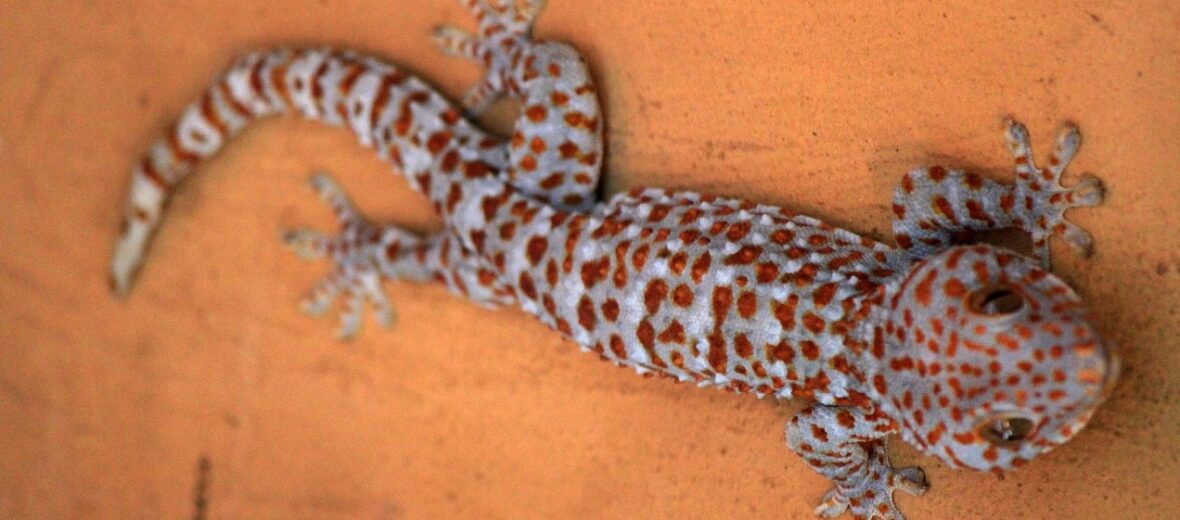
Coming in at number 2, for the world’s largest known gecko, it’s the Tokay gecko. With light blue skin, sporting red & white specs, and packing one heck of a bite this gecko is a favorite of exotic reptile keepers the world over. I have only known 1 that was not aggressive. Typically they all want to bite your face off. Due to their shear numbers, this gecko is listed as Least Concern by the IUCN; but their numbers are falling in the wild.
First the Stats…
Scientific name: Gekko gecko
Weight: Up to 14 ounces
Length: Up to 12 inches
Lifespan: Up to 20 years
Now on to the Facts!
1.) Tokay geckos are often let loose in houses to help control pest populations of insects and rodents.
2.) Their ears are located on either side of their head and the eardrum is so shear that you can quite literally see through their head to the other side.
3.) They are native to south and south-eastern Asia including: Malaysia, the Philippines, and Indonesian archipelago.
4.) These fierce predators have also been introduced to Florida, Hawaii, Texas, Belize, and a few Caribbean islands. They are considered a potentially invasive species in these locations.
5.) Tokays are primarily nocturnal (active at night) with some crepuscular (active at dawn and dusk) activity.
But wait, there’s more on the Tokay gecko!
6.) Due to their powerful jaws, they can inflict a painful bite and tend to lock down and hold on to you when they do bite you. Which they will bite… often.
7.) Like many other geckos, they are arboreal (spend their lives in trees) and able to climb any surface with the greatest of ease. They can even climb glass.
Did you know…?
These geckos have a perietal eye. This is a third eye that is located at the top of their head. This rudimentary eye can only see light and dark. It is believed it helps them to watch out for predators.
8.) All arboreal geckos, like the Tokay, can cling to any surface via a principal called “van der Waals force”. This is where the tiny hairs on their toes (called setae) come into contact with various surfaces. Each seta splits off into hundreds of even smaller bristles called spatulae. A physical bond happens when electrons from the gecko hair molecules and electrons from the surface molecules interact with each other and thus create an electromagnetic attraction.
9.) The male’s calls sound like, “token”, “gekk-gekk”, “tuck-too”, “poo-kay”, or “to-kay”; which is how they got their common name. Females are mute and can only hiss.
10.) These geckos prey on insects, spiders, mice, small rats, other lizards, and even small snakes.
But wait, there’s still more on the Tokay gecko!
11.) Their nostrils are used for breathing and picking up the scent of nearby prey. They also depend on their Jacobson’s organ (a special organ used to get a readout of air molecules picked up by the gecko’s tongue) to track potential food.
Did you know…?
Tokays have special folds of skin that prevent them from casting a shadow when they are resting on a tree or other surface. They open up the skin folds completely thus allowing them to blend in with the tree bark or other perch.
12.) They are preyed on by larger lizards, snakes, and birds.
13.) Females lay 2 eggs in multiple clutches throughout the year. She will guard the eggs till they hatch.
14.) As a defense, these geckos can drop their tail in what is called caudal autotomy. This shed tail wildly wriggles for up to 30 minutes, distracting the predator long enough for the gecko to escape.
15.) In Southeast Asia, the Tokay is a symbol of good luck and fertility.
Now a Short Tokay Gecko Video!
Also, check out the Critter Science YouTube channel. Videos added frequently!
Want to suggest a critter for me to write about? Let me know here.



